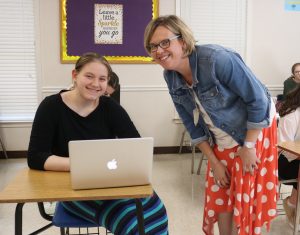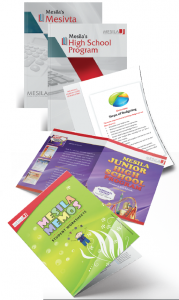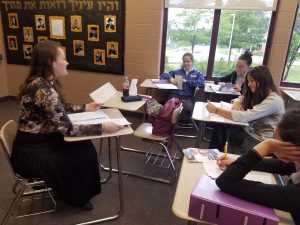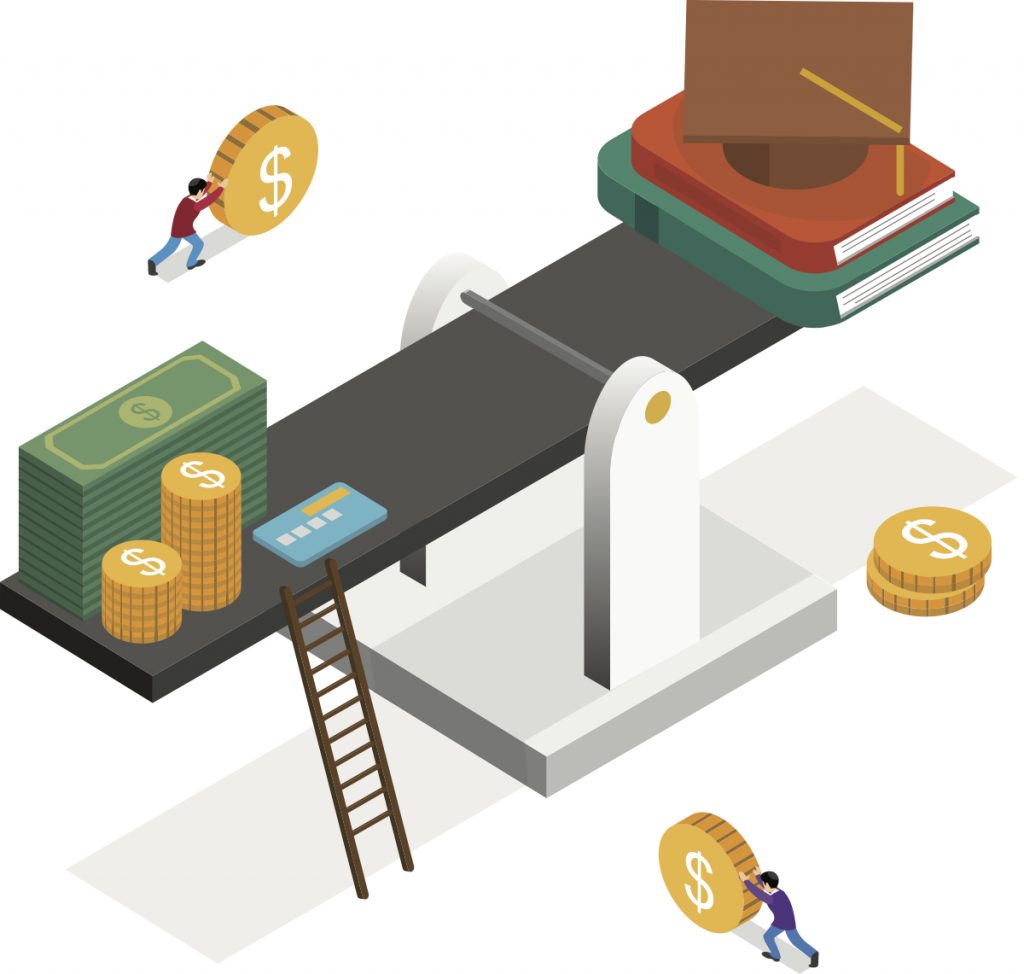Frumonomics: Teaching Frum Kids to Live Financially Responsible Lives
A Growing Number of Day Schools Are Taking Financial Literacy Seriously
Ten years from now, Yehudis Tova Samuels probably won’t be a literary editor living in Chicago. That’s because, after extensive research into salaries and costs of living, her projected monthly budget for the location and career of her choice was in the red by $78—“even without putting aside any money for retirement!” she says.

Yehudis Tova Samuels (left), a student at the Goldie Margolin School for Girls in Memphis, with her teacher Rhonda Martin. One of the exercises Martin uses in her financial literacy class is to have her students imagine their lives ten years down the road and crunch the numbers. Courtesy of Goldie Margolin School for Girls
Samuels is in twelfth grade at the Goldie Margolin School for Girls (GMSG) in Memphis, Tennessee, where last year she took a required course in personal finance. Under the guidance of their teacher, Rhonda Martin, she and her classmates were tasked with imagining their lives ten years down the road and crunching the numbers. “We planned out which college we would attend, if we would need student loans, our future jobs, where we would live,” Samuels explains. “Then, we calculated our estimated income based on our credentials, job and location. We tried to think of all of the possible expenses that might come up, from taxes and loans to groceries, clothes and entertainment.”
And when her numbers just didn’t add up?
“That was a big shock,” she says. “It quickly became apparent that this class is really important and that we still have a lot to learn.”
Tennessee is one of only seventeen states that require high school students to take a course in personal finance, according to the Council for Economic Education. This is despite growing indications that teens benefit from learning financial literacy in a formal setting. In fact, a recent T. Rowe Price study found that financial education in school is associated with better financial habits as an adult. Specifically, it found that young adults who received financial education are morely likely to have a budget (81 percent vs. 72 percent) and are more likely to say that they are good with money and finances (77 percent vs. 67 percent), among other findings.
In Jewish high schools across the country, administrators are beginning to see the practical value of introducing the subject to students, and several schools are incorporating personal finance into the curriculum. At the very least, most include a session on basic financial literacy as part of a senior-year seminar, but many schools—and experts—insist that those few hours are not sufficient to prepare students for real life. Some Jewish high schools now offer personal finance as an elective course and a growing number of schools are even requiring it.

Mesila, an Israeli company that opened a US branch in 2009, created financial education materials that are currently being used in approximately eighty-five Jewish day schools across North America. Courtesy of Mesila
The strongest push for offering such a course has come from the farther right sector of Orthodoxy. The trailblazer in this area has been Mesila, an organization committed to helping frum Jews achieve financial stability. Begun in Israel, Mesila opened its first US branches in 2009. Mesila (www.mesila.org) offers family financial coaching and business consulting for entrepreneurs and, in 2010, it expanded its mission to include financial education as well.
“After years of coaching thousands of families around the world on how to improve their finances, often as a remedy to financial ailments they were experiencing, we were prodded by community leaders to swing our focus to ‘an ounce of prevention,’” explains Mesila Founder and Executive Director Rabbi Shmuli Margulies. “Educating the youth to handle money correctly from the start was a project we had always dreamed of. . . . Once the necessary financial backing was acquired, the project of creating a financial education curriculum for the Jewish community was a logical response to an obvious need and quickly developed into a global enterprise.”
The Mesila curriculum is clearly filling a need in Orthodox education around the world. With branches in the UK, US, and Canada, the organization has created versions for girls’ high schools, boys’ yeshivot and junior highs. According to Chaya Roth, assistant director of Mesila USA, Mesila’s educational materials are being used this year in approximately eighty-five North American Jewish day schools in fifteen states and Canada.
“The schools using our curriculum are from across the spectrum,” says Roth. “We have Bais Yaakov-type schools, mesivtas, Yeshivish schools, Chassidic schools, Sephardic schools and co-ed schools.” Mesila’s curriculum covers a broad range of money-related topics, ranging from the technical—budgeting, use of credit, borrowing and lending—to the conceptual—the psychology of spending, wants vs. needs, tzedakah and financial integrity.
In Teaneck, New Jersey, veteran teacher Elise Vitow also noticed a lack of financial acumen at a girls’ school where she worked.
“People came to do a presentation about retirement planning for the teachers,” she recalls. “The questions teachers were asking were so basic, and these were not all young teachers.” With her strong interest in personal finance, Vitow brought up the idea of offering it as an elective for the students.
“We teach the girls to advocate for themselves and be independent,” she notes. “Shouldn’t we teach them financial literacy as part of this goal?” The school was supportive of the idea and Vitow developed a course and taught it to seniors for several years as an elective until she left the school in 2017; the school continues to offer the course.
A recent study from the money app BusyKid showed that only 21 percent of parents regularly talk about money with their kids and only 10 percent are interested in teaching them about managing credit cards or investing. There are no indications that these numbers are different in the Jewish community.

All too often, high school graduates are congratulated swiftly, only to be told “welcome to the real world!” All of a sudden, resumes must be written, jobs must be obtained, and credit must be built. In our world today, it is too easy to overspend on credit cards and undervalue healthy financial habits. For these reasons, Hebrew Academy of Cleveland’s Beatrice J. Stone Yavne High School prepares their seniors for life after high school with their Financial Literacy Class. This course teaches all the essentials, from resume writing to interview skills to stock market investment. Through interactive activities and projects, students learn that “moderation in all things” is a skill learned. Courtesy of Yavne High School
In fact, Vitow noted that her students had picked up very little understanding of money from home. “The girls really didn’t know very much about the topic at all,” she says. “From the strongest students to the weakest students, everyone in the class was starting at the same point.”
“Financial literacy education impacts every individual’s quality of life and is important for everybody,” notes Rabbi Margulies of Mesila. “But in the frum community, this program is different and even more crucial. It is a Torah requirement to use money wisely, and the frum community has different challenges from the general population, such as a heavy tuition load, yom tov expenses, large families, et cetera. These unique circumstances must be provided for by strong financial foundations.”
Tamar Snyder, a journalist who created a curriculum on financial literacy for Jewish Women International’s Life$avings Project, adds another important difference in teaching Jewish teens.
“In the secular world, charity is a discretionary expense,” she says. “It’s the first thing to cut when money is tight. But it’s a priority for us, and not something we can cut.”
Snyder estimates she taught her curriculum to about 750 Jewish girls from all different backgrounds, through high schools, youth groups and JCCs. “People were really thirsty for this,” she recalls. “They were excited about it.”
After Snyder presented her material at Manhattan High School for Girls, the administration asked if she would return to teach a mandatory yearlong course on financial literacy. Snyder taught the course there for two years. A highlight of the course was a budgeting project similar to what the students at GMSG in Memphis did, though in her class, students were assumed to be married with three children—so they were forced to consider the financial realities that would come with marrying a man learning in kollel vs. working, in addition to factoring tuition into their budgets.
Though Snyder now works full-time in marketing and communications, she continues to lead seminars for high school students on personal finance, which she dubs “Everything I wish I knew about money when I was your age.” She also offers budget consulting for Orthodox newlyweds and young professionals, through her web site newlywedbudgeting.com.
“I love teaching people before they get into trouble with money,” she explains. “It’s so much easier to help someone when they’re starting out and haven’t made mistakes. Teenagers today literally don’t know how credit cards work, and yet some of them already have credit cards. This leads to complicated and sad situations that could have been avoided.”
To Snyder, creating a budget is simply about “telling your money where you want it to go.” And this, she maintains, is not intuitive for anyone. “If young people have never done this, they won’t be able to suddenly do it [when they leave home for the first time],” she says. “They need to be taught.”
Snyder enjoys teaching seminars to high school seniors about personal finance, but she believes that Jewish high schools should be requiring the subject as a mandatory course. “It’s not as effective [to offer the subject] as an optional class or a club,” she says. “The students who need it the most are the least interested. They simply won’t take it as an elective.”

DRS Yeshiva High School for Boys offers a course, called Personal Financial Literacy, that covers a wide range of topics in personal finance and financial planning, from budgeting to understanding mortgages to the importance of building a credit score. Courtesy of DRS
Davis Renov Stahler Yeshiva High School for Boys (DRS) on Long Island, New York has offered a course called Personal Financial Literacy to seniors for the past several years. According to Dr. Hillel Broder, general studies principal of DRS, the course covers a wide range of topics in personal finance and financial planning including budgeting and understanding assets vs. liabilities, planning for retirement, understanding the mortgage process, methods of saving, methods of investing, the value of education in relation to income, the importance of building credit and more.
“Almost every student in the history of education has uttered the question ‘Why do I need to learn this?’” says Dr. Broder. “As frustrating as that can be for an educator to hear, students in Personal Financial Literacy do not ask that, because they realize the value of the information both in the short-term and as they continue into college and enter the intimidating world of adulthood.”
Back in Memphis, Rhonda Martin says the topic that most surprises her students is taxes.
“They looked at pay statements from New York City, as opposed to Memphis,” she explains. “Since our students come from across the country, they are familiar with the cost of living in other cities, but it was eye-opening for them to see the difference between gross salary and net salary, and how much you take home depending on where you choose to live. I think they were shocked to discover how little control they would have in that.”
Chris Allulis, who taught a mandatory course in personal finance last year to juniors at Beth Tfiloh Dahan Community School in Baltimore, said the primary goal of his course was to have students come out of high school with a basic understanding of finance, enough to help them make good choices as they become more financially independent. However, he added, “the students generally don’t like learning about interest, loans, budgeting or taxes.”
I love teaching people before they get into trouble with money. It’s so much easier to help someone when they’re starting out and haven’t made mistakes.
Allulis found that while his students enjoyed learning about investing and discussing how current events affect world markets, it can be difficult to communicate the importance of making solid financial decisions to students who haven’t yet had to be financially independent.
Yehudis Tova Samuels might be rethinking her plans for the future, but she isn’t feeling discouraged. She thinks she has a more realistic grasp now of how her decisions in the next few years could affect her future and her hopes of living comfortably as an observant Jew.
“Before taking this course, I basically knew that saving was good and wasting was bad, but I didn’t know much more than that,” she says. “This has given me the tools to feel prepared for the next stage of life.”
Rachel Schwartzberg works as a writer and editor and lives with her family in Memphis, Tennessee. Special thanks to financial writer Cheryl Munk who assisted in the research.

